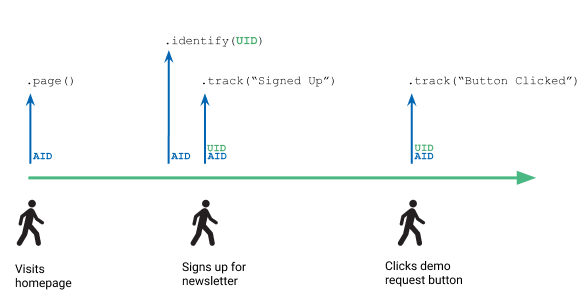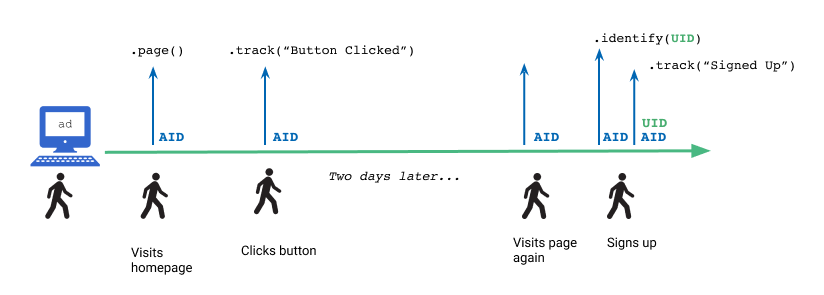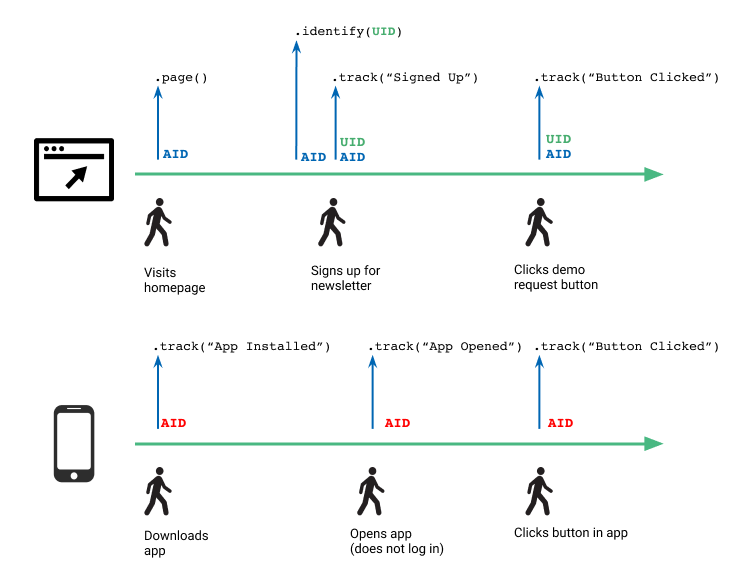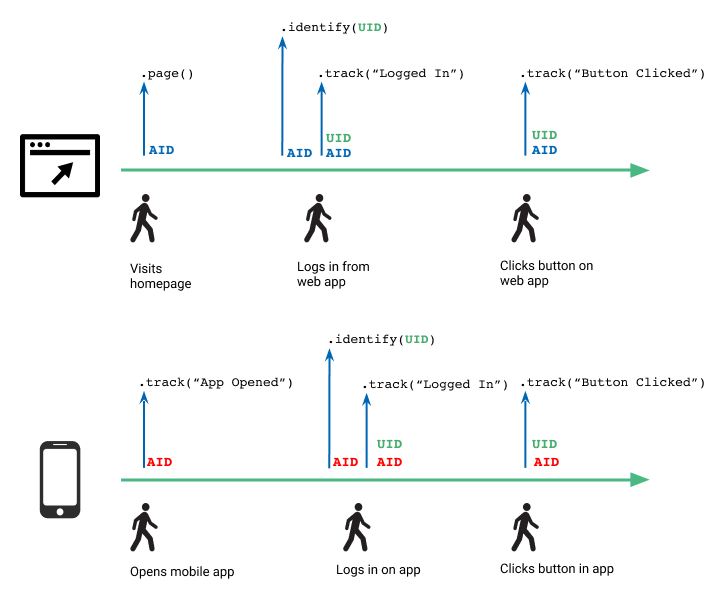Best Practices for Identifying Users
The most important calls you make with Segment are the identify and track calls. When you use these calls together, you can attribute actions on your site or app to individuals, and gain a better understanding of their activities, identity, and use patterns over time. Tracking users with the identify and track calls reduces the number of Monthly Tracked Users you are billed for.
Identifying users
The Identify call specifies a customer identity that you can reference across the customer’s lifetime. There are instances where you want to record information about a user that isn’t already known to you. An example of this might be, a user that visits your site and doesn’t register, but they do give you their email address through a newsletter email sign-up form. In this instance, you would record that email address as a trait, and for the identifier (ID), you would use anonymous ID.
When you make an identify call using Segment’s Analytics.js library, Segment saves the userId to the browser cookie, and writes all the user traits in localStorage. If you’re using one of the Segment mobile libraries, the userId and traits are stored in the device’s memory. This makes it possible to append the user’s data to all subsequent page calls or track calls for the user, so you can properly attribute those actions.
If a user returns to your site after the cookie expires, Analytics.js looks for an old ID in the user’s localStorage, and if one is found, sets it as the user’s ID again in a new cookie. If the user clears their cookies and localStorage, all of the IDs are removed and the user gets a completely new anonymousId when they next visit the page.
Whenever possible, follow the Identify call with a Track event that records what caused the user to be identified.
AnonymousId generation
If you’re using Segment’s browser or mobile libraries, the Segment SDK generates and sets a UUID as anonymousID at the user’s first visit to your site. That anonymousId is saved in the user’s cookie, as well as localStorage, and will stick with that user until the cache is cleared or a reset call is triggered.
You can use the anonymousId to link events performed by the user as they navigate around your website. When you track the anonymousId, you can attribute activities over multiple days to the same user by collecting all of the activities with that ID. If a user chooses to register for your site, or log in to your app, you can Identify them, and still include their anonymousId in the event payload along with the new userId.
If you use Segment’s server libraries, you must generate an anonymousId manually. It can be any pseudo-unique identifier, for example, you might use a sessionId from a backend server.
Best options for userIds
Segment recommends that you use a unique user identifier (UUID) that won’t change for your userId. A userId should be a robust, static, unique identifier that you recognize a user by in your own database systems. Because these IDs are consistent across a customer’s lifetime, you should include a userId in Identify calls as often as you can. If you don’t have a userId, you need to include an anonymousId in your Identify call in order to record identifying information about your user.
Ideally, the userId could be a database ID. For example, if you’re using MongoDB it might be a row identifier and look something like 507f191e810c19729de860ea. These can also be UUIDs that you generate somewhere in your application. You can also use identifiers that you get from other tools - such as Shopify or Braze - however this approach can lead to extra complexity in your systems.
Segment does not recommend using simple email addresses or usernames as a User ID, as these can change over time. Segment recommends that you use static IDs instead, so the IDs never change. When you use a static ID, you can still recognize the user in your analytics tools, even if the user changes their email address. And even better, you can link your analytics data with your own internal database.
Tip! Even though Segment doesn’t recommend using an email address or a username as a User ID, you can still send that identifying information in your Identify call as traits.
When to call Identify
You should make an Identify call in the following situations:
- When the user provides any identifying information (such as a newsletter sign-up with email and name)
- When first you create a user (and so it is assigned a
userId) - When a user changes information in their profile
- When a user logs in
- (Optional) Upon loading any pages that are accessible by a logged in user
Soft User Registration
An anonymous user visits the site for the very first time. The home page has the analytics.js tracking snippet loaded in its header. When the page loads, this sets off the default Page call to Segment. The Segment SDK generates and sets anonymousId.
analytics.page({
path: '/',
title: 'Home Page',
url: 'https://somesite.com/',
})
You can see in this full page event, the anonymousId is populated, and the userId is null.
{
"anonymousId": "bd077b70-816b-448b-ae79-2f5f7d856513"
"context": {
"ip": "0.0.0.0",
"library": {
"name": "analytics.js",
"version": "3.11.4"
},
"locale": "en-US",
"page":{
"path":"/"
"referrer": "",
"search": "",
"title": "Home Page",
"url": "https://somesite.com"
},
"userAgent": "Mozilla/5.0"
},
"integrations": {},
"messageId": "ajs-84d32beb4273e661a2257bfef41c4964",
"originalTimestamp": "2020-04-23T22:38:48.55Z",
"properties":{
"path": "/",
"referrer": "",
"search": "",
"title": "Home Page",
"url": "https://somesite.com"
},
"receivedAt": "2020-04-23T22:38:48.55Z",
"sentAt": "2020-04-23T22:38:48.55Z",
"timestamp": "2020-04-23T22:38:48.55Z",
"type": "page",
"userId": null
}
The user signs up for an email newsletter and fills out the form giving you their first and last name, as well as their email address. At this point, you will fire off an Identify call. You won’t yet assign them a user ID in this example, but you can still grab these traits about them.
analytics.identify({
firstName: 'Joe',
lastName: 'Visitor',
email: 'jvisitor@thissite.com'
});
You’ll notice the Identify call contains no userId. These traits will be associated to the anonymousId that is available in the user’s cookie and localStorage.
{
"anonymousId": "bd077b70-816b-448b-ae79-2f5f7d856513"
"context": {
"ip": "0.0.0.0",
"library": {
"name": "analytics.js",
"version": "3.11.4"
},
"locale": "en-US",
"page":{
"path":"/"
"referrer": "",
"search": "",
"title": "Email Signup",
"url": "https://somesite.email"
},
"userAgent": "Mozilla/5.0"
},
"integrations": {},
"messageId": "ajs-84d32beb4273e661a2257bfef41c4964",
"originalTimestamp": "2020-04-23T22:38:48.55Z",
"properties":{
"path": "/",
"referrer": "",
"search": "",
"title": "Home Page",
"url": "https://somesite.com"
},
"receivedAt": "2020-04-23T22:38:48.55Z",
"sentAt": "2020-04-23T22:38:48.55Z",
"timestamp": "2020-04-23T22:38:48.55Z",
"traits"{
"email": "jvisitor@thissite.com",
"first_name": "Joe"
"last_name": "Visitor"
},
"type": "page",
"userId": null
}
Full User Registration
An anonymous visitor registers for an account and becomes a known user. The account creation process allows you to assign a userId from your production database and capture additional traits. For this example, the userId that is assigned is “123abc”. This is when you’ll want to fire an Identify call with this user’s newly assigned userId and additional traits.
analytics.identify(`123abc`,{
phone: '555-555-5555',
address: {
street: '6th Street',
city: 'San Fransisco',
state: 'CA',
postalCode: '94103',
country: 'US',
}
});
After you fire the Identify call with the userId, you’ll notice that the payload now has both a userId and an anonymousId attributed to the user.
{
"anonymousId": "bd077b70-816b-448b-ae79-2f5f7d856513"
"context": {
"ip": "0.0.0.0",
"library": {
"name": "analytics.js",
"version": "3.11.4"
},
"locale": "en-US",
"page":{
"path":"/"
"referrer": "",
"search": "",
"title": "Email Signup",
"url": "https://somesite.email"
},
"userAgent": "Mozilla/5.0"
},
"integrations": {},
"messageId": "ajs-84d32beb4273e661a2257bfef41c4964",
"originalTimestamp": "2020-04-23T22:38:48.55Z",
"properties":{
"path": "/",
"referrer": "",
"search": "",
"title": "Home Page",
"url": "https://somesite.com"
},
"receivedAt": "2020-04-23T22:38:48.55Z",
"sentAt": "2020-04-23T22:38:48.55Z",
"timestamp": "2020-04-23T22:38:48.55Z",
"traits"{
"phone": '555-555-5555',
"address": {
"street": '6th Street',
"city": 'San Fransisco',
"state": 'CA',
"postalCode": '94103',
"country": 'US',
}
},
"type": "page",
"userId": "123abc"
}
Merging Identified and Anonymous user profiles
The illustration below shows a timeline with a user’s interactions on a website, including sample API calls above that show Segment calls, and the user’s anonymousId and userId.

When the user first visits a page, Analytics.js automatically assigns the user an anonymousId and saves it to the user’s localStorage. As the user interacts with the site, for example clicking around to different pages, Analytics.js includes this anonymousId and some contextual information with each Page and Track call. The contextual information might be the user’s IP address, browser, and more.
When a user signs up to create an account on the website, the .identify("userId") and .track(“Signed Up”) events fire, in that order. You pull the userId unique to the user from your systems, and send it to the Segment library so you can label that user’s later events with their ID. The later Track call (“Signed Up”) contains both the userId and the automatically-collected anonymousId for the user, and any other information you capture about them - such as their first name, last name, and email address.
The example below shows an Identify call including user traits. It uses a database ID (97980cfea0067) as the userId.
analytics.identify("97980cfea0067", {
name: "Peter Gibbons", //user trait
email: "peter@example.com", //user trait
plan: "premium" //user trait
});
For a Track call, information about this event is stored either in the context field or in the event properties. The example below shows a Track call including properties that tell you about the user.
analytics.track("Signed Up", {
userId: "97980cfea0067", //event property
name: "Peter Gibbons", //event property
email: "peter@example.com", //event property
plan: "premium" //event property
});
Additionally, Analytics.js adds a message_id and four timestamps to the call.
Now, as the user interacts with your site and different buttons or links that you track using Segment, their userId and anonymousId are sent with each subsequent tracking API call.
UserId merge examples
Let’s go through some more scenarios to explain how an anonymousId is assigned and how it might be merged with a userId.
Scenario #1 - Multi-day, single device
If a user clicks on an ad and is directed to a webpage, they are assigned an anonymousId. While this user is anonymous, they navigate to different pages and click around on the website. Say they come back two days later from the same device, sign up, and are assigned a userId from your database.

For simplicity, we’re assuming that the user has not cleared their cookies or localStorage, where the original anonymousId is stored. If they had, they’d be assigned a new anonymousId when they visited the website, and the userId they got when they register on the website would not be attached to the activities tracked with the old anonymousId.
Scenario #2 - Multi-day, multi-device, single login
In this scenario, the person uses both a web browser, and a mobile application to interact with your site. In each case, they are assigned a different anonymousId. In this scenario, the user signs up on the web browser, so Segment assigns their web session a userId. However, because they do not log in on the mobile application, Segment cannot tie the mobile activity to this specific user. Their mobile application activity remains anonymous unless they log in on the mobile application.

Scenario #3 - Multi-day, multi-device, multiple logins
Similar to the previous scenario, the user accessed both your website and mobile application, and also logged in on both. In this case, both sessions on the web and mobile app receive the user’s userId, so Segment can tie the anonymous activity on both web and mobile to this user.

User profiles in warehouses
Your data warehouse has a schema for each of your Segment sources. User information is stored in two tables in your source schemas - the identifies and users table.
The identifies table contains all of your identify events, and the timestamps for these events. Every time you make an Identify call, Segment adds the userId, anonymousId, any updated or added user traits from the call, as well as the timestamp of when the call was made. Your identifies table is your first stop when you have questions about users and their traits.
The users table contains only unique Identify method calls, and is a collation of the identifies table. The users table is the single source of truth for a user’s most up-to-date traits.
These tables only contain information about a user once they have been identified. However, you can still find information about an anonymous user on the pages, screens, and tracks tables, as well as the individual track event tables.
ID expiration and overwriting
The Segment ID cookie is set with a one year expiration. However, there are some ways an ID can be reset or overwritten:
- If you call
resetduring a user’s browser session, it removes both theiruserIdandanonymousId, which means the user generates a newanonymousIdon the next visit. - If the user manually clears their cookies and local storage, they generate a new
anonymousIdon the next visit. - If you invoke any call before you set an
anonymousId, Segment automatically sets theanonymousIdfirst. This means if you explicitly set ananonymousId, you might give the user twoanonymousIds or overwrite an existing one. - If you fetch the
anonymousIdusinganalytics.user().anonymousId()before one is set, Segment generates and sets ananonymousIdrather than returningnull. - If you call
analytics.identify()with auserIdthat is different from the currently cacheduserId, this can overwrite the existing one and cause attribution problems. - If you generate a new
anonymousIdon a server library, and pass it from the server to the browser, this could overwrite the user’s existinganonymousId.
Remember, if a user has multiple devices, they can have different anonymousIds on each different device.
Linking server and client generated Ids
If you’re tracking on the client and on the server, the anonymousId can be retrieved from localStorage on the client and passed to the server. You can access a user’s anonymousId using the following call:
analytics.user().anonymousId()
If you’re identifying on the server, then you will want to pass the user ID from the server to the client using an Identify call with the anonymousId. That will allow the userId to be aliased with the existing anonymousId and stored in the cookie in localStorage. With that, all previous anonymous activity and all subsequent activity is associated to the newly generated userId, as well as existing anonymousIds.
There are some advantages to sending details about your users directly from your server once the user registers. Server library Identify calls are invisible to the end user, making them more secure, and much more reliable. Or, if you want to send user data that is sensitive or which you don’t want to expose to the client, then you can make an Identify call from the server with all the traits you know about the user. More about collecting data on the client or server in Segment’s documentation.
Aliasing from a server library
If you plan to track anonymous visitors from the browser and only make Identify calls from your server libraries, Kissmetrics and Mixpanel might require that you make an Alias call to link the records. The Alias call links client-side anonymous visitors with server-identified users. This isn’t recommended, but if you do this, read the Kissmetrics and Mixpanel specific alias docs.
Common questions
There are a few things that might cause your numbers to be off.
Missing sign-ups
The most common problem people run into when tracking new user signups client-side is that only a portion of their new users are showing up in reports.
This is usually caused by the page redirecting or reloading before the tracking calls get a chance to run. Segment recommends that you make those calls from a welcome page after the user registers, rather than trying to squeeze in the tracking calls on the sign-up page itself.
Anonymous history is lost
This is usually only an issue in Mixpanel, since it’s the only destination that requires a call to alias in the browser to link anonymous browsing history to a new identified user.
Remember that for destinations that require aliasing, you must make the Alias call before you make the Identify call for that user. Even if you make an Identify call from a server library, it can’t happen before the client-side alias.
Can you update a userId?
Unfortunately, there is no way to change an existing userId within Segment. Historical data with an existing userId remains the same, and a new userId will not replace the existing userId in Segment event call logs. For downstream destinations, consult the corresponding docs about user profile behaviors when using a new userId.
Changing a userId is incredibly hard to do, as that is a fundamental part of analytics. While some downstream analytics tools let you change a userId once set, others don’t and the process will be different for each tool.
This page was last modified: 15 Mar 2024
Need support?
Questions? Problems? Need more info? Contact Segment Support for assistance!